Skin Pustules – Friday Pop Quiz 1/20/2023
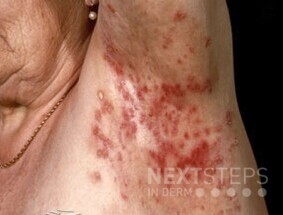 A patient comes in with the rash pictured below consisting of pustules in an annular or polycyclic configuration. What type of paraproteinemia can this disorder be associated with and thus a workup should be initiated for?
A. IgG kappa
B. IgG lambda
C. IgA
D. IgM
E. IgD
To find out the correct answer and read the explanation, click here.
Brought to you by our brand …
A patient comes in with the rash pictured below consisting of pustules in an annular or polycyclic configuration. What type of paraproteinemia can this disorder be associated with and thus a workup should be initiated for?
A. IgG kappa
B. IgG lambda
C. IgA
D. IgM
E. IgD
To find out the correct answer and read the explanation, click here.
Brought to you by our brand …
 A patient comes in with the rash pictured below consisting of pustules in an annular or polycyclic configuration. What type of paraproteinemia can this disorder be associated with and thus a workup should be initiated for?
A. IgG kappa
B. IgG lambda
C. IgA
D. IgM
E. IgD
To find out the correct answer and read the explanation, click here.
Brought to you by our brand …
A patient comes in with the rash pictured below consisting of pustules in an annular or polycyclic configuration. What type of paraproteinemia can this disorder be associated with and thus a workup should be initiated for?
A. IgG kappa
B. IgG lambda
C. IgA
D. IgM
E. IgD
To find out the correct answer and read the explanation, click here.
Brought to you by our brand … Continue reading "Skin Pustules – Friday Pop Quiz 1/20/2023"


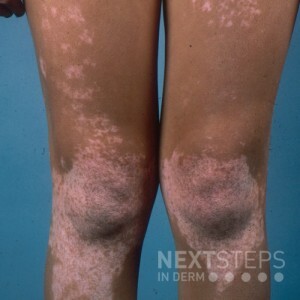 What mutation is responsible for this clinical presentation in a patient with both thyroid dysfunction and chronic candidal infections?
A. Autoimmune regulator (AIRE)
B. Phosphatase and tensin homolog (PTEN)
C. Tyrosine related protein 1 (TRP1)
D. Fumarate hydratase (FH)
E. Lysosomal trafficking regulator (LYST)
To find out the correct answer and read the explanation, …
What mutation is responsible for this clinical presentation in a patient with both thyroid dysfunction and chronic candidal infections?
A. Autoimmune regulator (AIRE)
B. Phosphatase and tensin homolog (PTEN)
C. Tyrosine related protein 1 (TRP1)
D. Fumarate hydratase (FH)
E. Lysosomal trafficking regulator (LYST)
To find out the correct answer and read the explanation, … 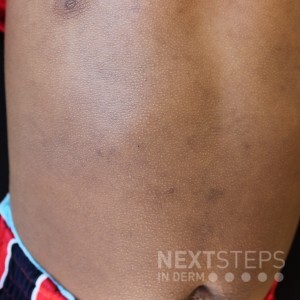 An 8-month-old boy is brought in by his mother for concerns of a rash that comes and goes for the last few months, primarily on his face and belly. His older brother suffers from asthma and often has a similar rash on the inside of his elbow and behind his knees.
The gene most commonly mutated in the photograph is also mutated in which of the following?
A.) Palmoplantar keratoderma
B.)� …
An 8-month-old boy is brought in by his mother for concerns of a rash that comes and goes for the last few months, primarily on his face and belly. His older brother suffers from asthma and often has a similar rash on the inside of his elbow and behind his knees.
The gene most commonly mutated in the photograph is also mutated in which of the following?
A.) Palmoplantar keratoderma
B.)� … 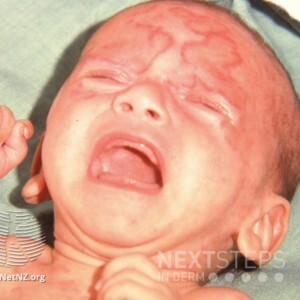 A 2 day-old infant is being seen in the hospital for the following rash. Which of the following is not true about the infant’s disease?
A. Skin lesions typically resolve without scarring
B. There is a strong association with anti-SSA/Ro antibodies
C. There are also reports of the presence of U1RNP antibodies
D. Lesions have a predilection for the face
E. Heart block often deve …
A 2 day-old infant is being seen in the hospital for the following rash. Which of the following is not true about the infant’s disease?
A. Skin lesions typically resolve without scarring
B. There is a strong association with anti-SSA/Ro antibodies
C. There are also reports of the presence of U1RNP antibodies
D. Lesions have a predilection for the face
E. Heart block often deve … 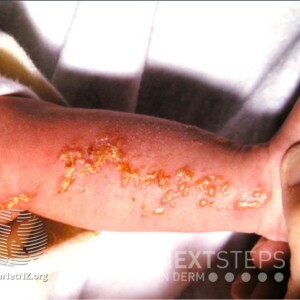 Which of the following conditions may be associated with dental findings resembling those seen in the genetic condition featured in the picture above?
A. Ectodermal dysplasias
B. Pachyonychia congenita type 2
C. Hyper-IgE syndrome
D. Congenital erythropoietic porphyria
E. Gardner syndrome
F. Letterer-Siwe disease
G. Papillon-Lefevre syndrome
H. Sjogren-Larsson syndrome
…
Which of the following conditions may be associated with dental findings resembling those seen in the genetic condition featured in the picture above?
A. Ectodermal dysplasias
B. Pachyonychia congenita type 2
C. Hyper-IgE syndrome
D. Congenital erythropoietic porphyria
E. Gardner syndrome
F. Letterer-Siwe disease
G. Papillon-Lefevre syndrome
H. Sjogren-Larsson syndrome
…